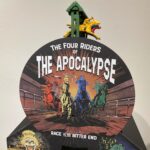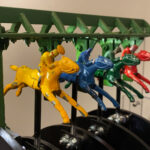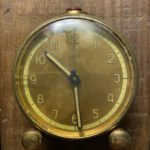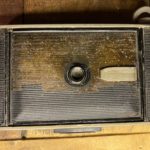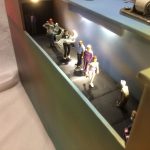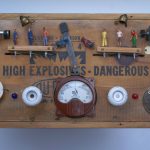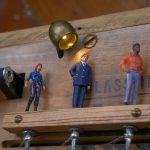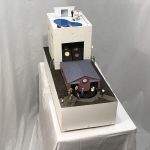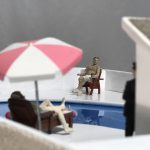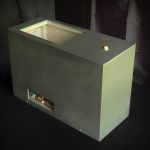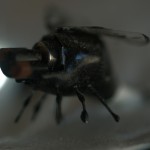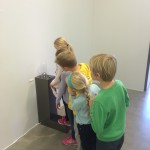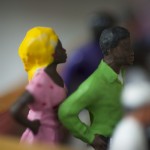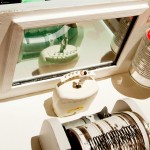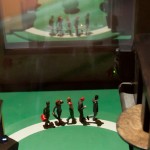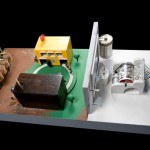Works

“The Four Riders of the Apocalypse Race to the Bitter End”
History tells us that Emperor Nero played the fiddle while Rome burned. Today, people in the Western world, like a modern-day Nero, spend more time playing games than ever before—even as the world is literally on fire. The Four Riders of the Apocalypse Race to the Bitter End is an interactive kinetic artwork that critiques this escapist tendency and reimagines the biblical figures to embody humanity’s greatest contemporary threats: the climate crisis, artificial intelligence, pandemics, and nuclear war. The piece merges an old-fashioned game mechanism with a darkly satirical twist, inviting viewers to bet on which version of the end of the world will “win.”
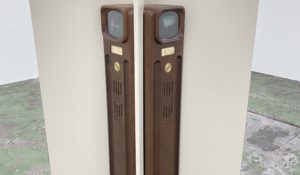
“Childhood”
The strong connection between the sense of smell and memories is the result of the olfactory bulb, which processes smells, being closely linked to the amygdala and hippocampus regions of the brain. The amygdala associates emotional responses with specific odours, while the hippocampus aids in forming and consolidating memories.
Childhood pairs the artist’s existing kinetic art practice, engaging the senses of sight and hearing, with a third sense: smell. The result is a kinetic scent sculpture/installation and a compelling multisensory experience. As Guy Bleus wrote in The Thrill of Working with Odours, 1978, “In plastic arts the application of odours has always been neglected, a few experiments excepted.” Utilizing the strong connection between smell and memory, as well as kinetic art’s ability to gradually reveal information to the viewer, Childhood triggers a unique interplay between the memories of the viewer and the artist.
Both the artwork’s content and form are impacted by the coronavirus pandemic. A common symptom of Covid-19 is losing the ability to smell, even after otherwise recovering from the virus. This artwork serves as a celebration of a sense we take for granted. Covid-19 has also impacted the project’s design: while experiencing the artwork, members of the public are isolated from one another, and do not need to touch the sculpture with their hands to activate it.
The artwork is centred on four significant memories from the artist’s childhood. These are personal but still likely shared by many. These memories are reconstructed from a combination of four distinct scents delivered by a microcomputer-controlled system, four evocative vintage photographs, and four short text fragments. The viewer is initially encouraged to form their own association by the prompt “What is that smell?” appearing on a small screen. Then, after a short delay, the photos and texts describing the artist’s memory associated with the smell are revealed. Each viewer is expected to have a unique experience in their encounter with the artwork. Just enough scent is delivered to be recognized by the viewer, but just little enough that no scent lingers in the exhibition space afterwards.
This multi-sensory experience is contained within a kiosk-like structure of elaborately carved and polished solid maple, inspired by post-war TV, radio and furniture design.
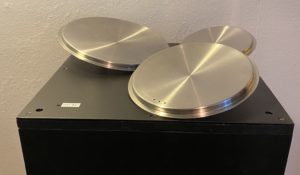
“Incessance”
A contemplation on gravity, resistance and the ravages of time.
Have you ever looked at a pot lid that begins to move on its own? As a kinetic artist, with a more than average interest in movement, this phenomenon was the starting point for a contemplation on gravity, resistance, and the march of time. I saw this movement as a metaphor for a human life itself. Because just as these three forces slowly and inexorably cause the pot lid to slow and eventually stop, our lives are much the same. Gravity slowly takes its toll on our bodies and life’s headwinds, challenges, and losses – resistance – slow us down too, over the course of our lives. But what if we could overcome all three forces? We cannot of course in our lives, but it turns out that we can do this for a pot lid. Hence it can, in theory, continue its motion forever, incessantly. The design and production of this kinetic artwork involved three prototypes and many hours of trial and error.
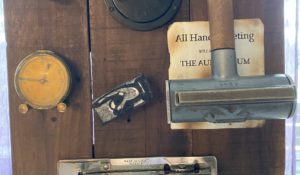
“Home Office 1936”
Working in a “home office” is a relatively new phenomena and became widespread during the corona pandemic. In our ancestors’ time a home office would have been unheard of. How was office life then, for example in 1936?
This kinetic sculpture is an analog expression of the digital home office, presented using several artifacts from the 1930s and other periods inherited from my grandparents and collected throughout my life.

“Smartphone 1936”
We now take our smartphones totally for granted. What did we do before we had them? What did our recent ancestors do, for example in 1936?
This kinetic sculpture is an analog expression of some digital smartphone functions, presented using several artifacts from the 1930s and other periods inherited from my grandparents and collected throughout my life.
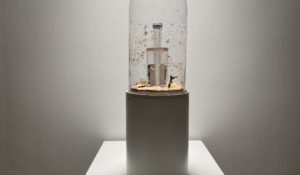
“Endless Summer”
Smartphone addiction is a reality. Physical friends are being replaced by virtual friends and real news by fake news. Virtual reality will accelerate this flight from actual reality. In a future of increasingly immersive artificial experience, what if humans succumb completely to the virtual realm while the physical world continues to deteriorate?
Endless Summer is a kinetic sculpture that contemplates an alternative but possible future where the twin environmental catastrophes of global warming and plastic pollution have spun out of control while a fortunate few have escaped into a physical and mental fantasy world of immersive virtual reality. But are they masters of this artificial environment or its slaves?
Fully contained in a small bell jar, two humans in full VR suits float inside a hermetically sealed artificial environment while a real environmental disaster howls outside. What are the wireless sensors and tubes connected to them – part of their VR system or something more sinister? What happens when the viewer pushes the start button, and what happens next?
This artwork is a rather dark, though logical extension of the artist’s previous kinetic works.

“Still Life”
“In 2008, adults spent an average of eighteen minutes on their phones per day; in 2015, they were spending two hours and forty-eight minutes per day… and up to 40 percent of the U.S. population suffers from some form of Internet-based addiction.”
― Adam Alter, Irresistible: The Rise of Addictive Technology and the Business of Keeping Us Hooked
“Still Life” is an interactive kinetic sculpture that focuses on the increasing pace of life from and dependency on our modern Internet-driven devices. The sculpture employs movement, microprocessor control, 3D printing, miniature video screens, audio, and video commentary from the viewer in a totally unique way. The work can, among other things, be used to inspire and teach children and young people about technology, programming, art and social studies.
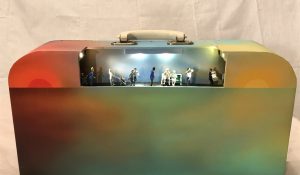
“Baggage”
This travelling kinetic sculpture began as a contemplation on a personal observation. As children, we live mostly in the present. We do not have much of a past to think about, at least not one we can remember. As teenagers we become much more oriented towards the future. And our future is wide open, full of possibilities. As we settle down and some of us have children, thoughts of their future keep us looking forward. At some point, when older, we begin to dwell increasingly on the past. Are we enriched by our life experiences or burdened by them?
At what point this happens varies from person to person. Some of us, even with 10, 20 or 30 years left to live, stop looking forward and start looking back; what might have been, what happened that should not have, regrets, happy memories, and not-so-happy memories. It is as if the past begins to consume more and more of our present, and in the process begins to cannibalize our future. The work shows people in many different life stages orienting themselves toward a sunset or a sunrise. The final form and content of the work developed as it was created, and as it emerged, the title of the work, “Baggage”, presented itself.

“Red State / Blue State”
In the USA in recent times voters have swung dramatically between the Republicans (red) and Democrats (blue). Representatives of both parties come out with wilder and wilder claims, accusations, promises, and more recently, outright lies, in order to be elected. Voters are becoming angrier and more polarized. At the same time, many states consistently vote “red” or “blue”, and elections are being decided in a small number of “purple” or “swing” states. The kinetic sculpture “Red State / Blue State” explores this phenomenon using an analogy from the world of electricity and an artistic expression that is pure steampunk. The sculpture is also inspired by the artist’s paternal grandfather, a lifelong Republican who was also fond of demonstrating the fateful power of dynamite.
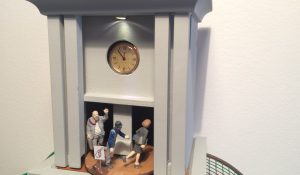
“Lives of Loyal Service”
“Saint Peter, don’t you call me ’cause I can’t go.
I owe my soul to the company store.”
– Sixteen Tons by Tennessee Ernie Ford, 1955
For some people these days, landing a permanent job in a big organization is a dream come true, a secure island of employment in a sea of uncertainty. But for others, contributing their whole lives to an organization, pledging loyalty to the company wherever that might lead, can be soul-destroying. For those people, freedom is more important than security. “Lives of Loyal Service” explores these ideas.
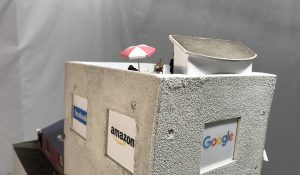
“eSerfs”
Micro jobs are tasks broken down to the smallest level, poorly paid and often given to those who bid the lowest price. This phenomenon is reminiscent for some of the Middle Ages when serfs had to work for a pittance for rich landowners.
The kinetic artwork “eSerfs” tries to illuminate this phenomenon in an accessible way. Workers representing the most common types of assignments go through a factory on a conveyor belt while others wait in line, and the logos of well-known micro job services light up in the windows. Gold coins move up to employers while copper coins move down as micro payments. Up in the office and apartment complex, well-guarded, the owners of the companies who benefit most from this arrangement enjoy the good life.
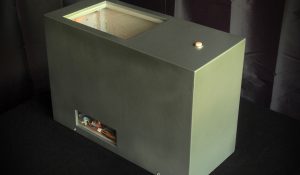
“Reach”
“Feed yourself with my life’s work.
How many likes is my life worth?” – Sick Boy by The Chainsmokers
How social is social media? In just a few years this phenomenon has taken over many people’s lives, with positive and negative results. How far are people willing to go for attention on social media? How do “friends” on social media compare to real physical friends? Does social media make people less lonely or more lonely? More satisfied with their lives or more envious of others? Are people becoming slaves to the moment and losing the ability to think long-term, to converse in person, and to concentrate?
“Reach” is a multimedia (but almost silent) kinetic sculpture that reflects on these questions and aims to inspire the viewer to do the same.
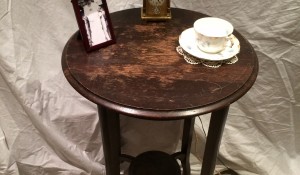
“Grandma's Time”
This kinetic sculpture is a tribute to the artist’s grandmother, a meditation about time and about a lost past. When the viewer approaches the work, several items with great sentimental value are set in motion, and musical fragments are played by a music box.
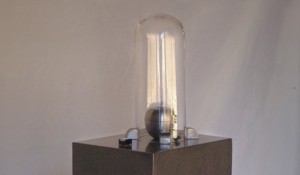
“Surveillance”
This kinetic sculpture explores the issue of surveillance in the international community in an allegorical form and through a multi-layered experience for the observer. Already when the observer starts the sculpture with the start button they experience the (simulated) discomfort of being fingerprinted without consent. The sculpture then presents a surveillance metaphor using tiny mechanical insects. During the complex mechanical sequence that follows the observer again experiences the (simulated) discomfort of being photographed without consent. The final layer in the experience of this sculpture is achieved through the observer being able to view the sculpture’s control board through a window in the pedestal. This control board is a kinetic sculpture in itself consisting of components labelled with their countries of origin: USA, Russia and China, the three biggest surveillance powers of modern times. The sculpture has an integrated step so that small children, who love kinetic sculptures, can also experience the artwork on their terms.
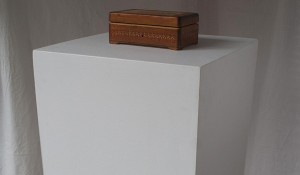
“Up North”
“Up North” is a special kind of musical candy box: a kinetic sculpture that explores the themes of immigration, refugees, otherness, identity and longing through figurative images, symbols and motion. The highly realistic small figures represent some of the immigrants and refugees trying to reach Europe, North America and Australia today. The collection of candies they gaze upon includes some of the most popular brands sold in the European countries considered the most desirable resettlement destinations. Candy and other luxury products are, of course, the last thing on the minds of people fleeing poverty, oppression and violence, and are used here to represent attractive, excessive and ultimately unrealistic recognition, status and wealth. The immigrants and the sweets are separated by a concrete wall topped with razor wire, representing the increasingly closed borders of the world’s wealthiest nations. While the would-be citizens stand up and down on their tiptoes to see over the wall, the candy moves slowly up and down and a music box plays “Somewhere Over the Rainbow,” a symbol of how many of us ignore or trivialize the plight of the refugees risking death to get into Europe.
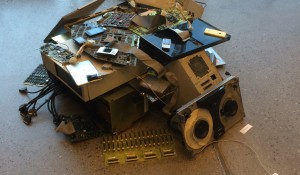
“Abandoned”
Every year in Norway and throughout the developed world we throw away thousands of tonnes of hazardous electronic and electrical waste. Less than half is recycled in a responsible manner. This e-waste ends up in poor countries where it pollutes, injures and kills plants, animals and people.
When we throw away these computers, tablets and mobile phones, we also lose fragments of our lives. The photos, songs, films and documents stored on these devices are also discarded, abandoned.
The work consists of several moving elements. These, along with small lights and fans give the impression that these abandoned objects breathe and live. There is also a soundtrack with fragments from home videos and recordings, and a slide show on a discarded flat screen.
Some of the photos in the slide show are typical images found on all computers and smart phones in Western countries interspersed with images of enormous e-waste landfill sites in Africa and China. These are used with permission from the “Basel Action Network. ” The soundtrack is played at a low volume so as not to distract from other works in the exhibition.
The purpose of this piece is to get people of all ages to ponder how we use, dispose of and abandon technology, memories and fragments of our lives .
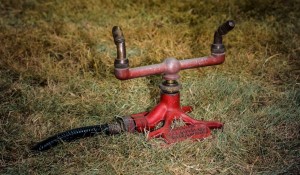
“Just Going Through the Motions”
How reliable are we? We often say important things without meaning them. We promise things without carrying through. We do things mechanically or just for show.
Unlike us, there are few things more reliable than lawn sprinklers , especially the solid models of brass and steel used by our our parents and grandparents. They have kept lawns, bushes and trees alive for several generations. In addition, they are beautiful objects in themselves. They invoke memories of summer days and running barefoot in through wet grass.
But here there is something that is not quite right, all is not as it should be.
Just going through the motions consists of three sprinklers that move exactly the same way they did when they were powered by water. Two are stationary and one moves slowly around a patch of real lawn. The work is protected from the public (and vice versa) by a low white picket fence.
The purpose of this work is to explore the difference between the superficial and the real, between what is said and what is done. It is also a small celebration of these humble servants in the yard.
This artwork is dedicated to Elijah McCoy (1844-1929), black Canadian engineer and inventor of the first lawn sprinkler
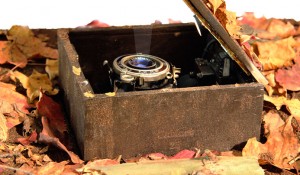
“Secrets II”
Secrets of many kinds are kept within families and by individuals. Some are harmless, others can etch away the glue that keeps families together and our sanity in place. Secrets II is meant to invoke in the viewer associations to hidden family secrets through collages of images and sound. This kinetic sculpture consists of a worn old box that is hidden under a moving forest floor. When the viewer starts the sculpture, the box rises up and projects a series of five slides while a soundtrack plays. The images hint at different types of secrets – historical and personal. The images are collages of public and private photos from the late 1800s, through the war years and the 1950s. A new picture series and soundtrack is presented each time the work is started. The work is completed but not yet exhibited.
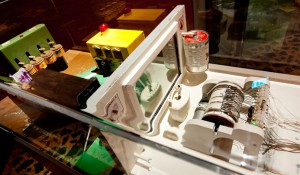
“Research”
Research addresses current sociological and political themes (research objectivity, the consumer society, working life, living in the shadow of terrorism, conspiracy theories, etc.) in a humorous and noisy way. The concept is based on a researcher / professor conducting social research which he also affects. The work pushes the so-called Hawthorne effect – that the very act of researching affects the subjects of the research – to its absurd conclusion. At the same time it seems that the researcher, through his one-way mirror, fails to see the consequences of his subjects’ actions, such as pollution, homelessness, etc. There are several sounds, lights and actions so there is something going on at all times. I hope that the audience experiences this work as funny, weird, unique and hopefully thought provoking.


